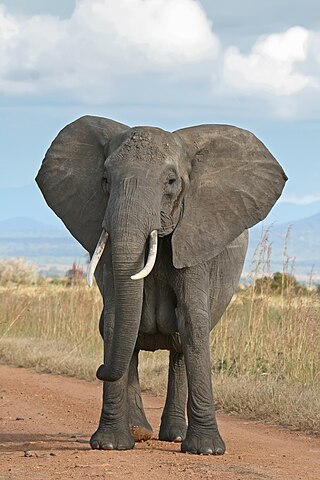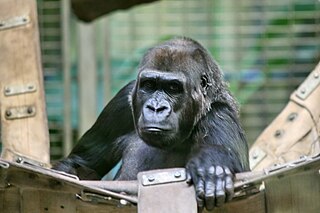
Poaching is the illegal hunting or capturing of wild animals, usually associated with land use rights. Poaching was once performed by impoverished peasants for subsistence purposes and to supplement meager diets. It was set against the hunting privileges of nobility and territorial rulers.

Kruger National Park is a South African National Park and one of the largest game reserves in Africa. It covers an area of 19,623 km2 (7,576 sq mi) in the provinces of Limpopo and Mpumalanga in northeastern South Africa, and extends 360 km (220 mi) from north to south and 65 km (40 mi) from east to west. The administrative headquarters are in Skukuza. Areas of the park were first protected by the government of the South African Republic in 1898, and it became South Africa's first national park in 1926.

The African forest elephant is one of the two living species of African elephant. It is native to humid tropical forests in West Africa and the Congo Basin. It is the smallest of the three living elephant species, reaching a shoulder height of 2.4 m. As with other African elephants, both sexes have straight, down-pointing tusks, which begin to grow once the animals reach 1–3 years old. The forest elephant lives in highly sociable family groups of up to 20 individuals. Since they forage primarily on leaves, seeds, fruit, and tree bark, they have often been referred to as the 'megagardener of the forest'; the species is one of many that contributes significantly to maintaining the composition, diversity and structure of the Guinean Forests of West Africa and the Congolese rainforests. Seeds of various plants will go through the elephant’s digestive tract and eventually pass through in the animal’s droppings, thus helping to maintain the spread and biodiversity of the forests.
Zakouma National Park is a 3,000 km2 (1,158 sq mi) national park in southeastern Chad, straddling the border of Guéra Region and Salamat Region. Zakouma is the nation's oldest national park, declared a national park in 1963 by presidential decree, giving it the highest form of protection available under the nation's laws. It has been managed by the nonprofit conservation organization African Parks since 2010 in partnership with Chad's government.

Garamba National Park is a national park in the north-eastern Democratic Republic of the Congo covering nearly 5,200 km2 (2,000 sq mi). It is among Africa's oldest parks and was designated a World Heritage Site by UNESCO in 1980 for its protection of critical habitat for northern white rhinoceroses, African elephants, hippopotamuses, and giraffes. Garamba National Park has been managed by African Parks in partnership with the Institut Congolais pour la Conservation de la Nature since 2005.

Environmental issues in Kenya include deforestation, soil erosion, desertification, water shortage and degraded water quality, flooding, poaching, and domestic and industrial pollution.

The East Sudanian savanna is a hot, dry, tropical savanna ecoregion of Central and East Africa.
The 2006 Zakouma elephant slaughter refers to a series of poaching massacres of African elephants in the vicinity of Zakouma National Park in southeastern Chad. These killings were documented in aerial surveys conducted from May through August 2006 and total at least 100 animals.

The wildlife of Chad is composed of its flora and fauna. Bush elephants, West African lions, buffalo, hippopotamuses, Kordofan giraffes, antelopes, African leopards, cheetahs, hyenas, and many species of snakes are found there, although most large carnivore populations have been drastically reduced since the early 20th century. Elephant poaching, particularly in the south of the country in areas such as Zakouma National Park, is a severe problem.

Dr. Iain Douglas-HamiltonCBE is a Scottish zoologist from Oxford University and one of the world's foremost authorities on the African elephant. Douglas-Hamilton pioneered the first in-depth scientific study of elephant social behaviour in Tanzania's Lake Manyara National Park, aged 23. His work in the 1960s paved the way for much of today’s understanding of elephants and current conservation practices. During the 1970s he investigated the status of elephants throughout Africa and was the first to alert the world to the ivory poaching holocaust, bringing about the first global ivory trade ban in 1989. In 1993, Douglas-Hamilton founded Save the Elephants, which is dedicated to securing a future for elephants and their habitats. For his work on elephants he was awarded two of conservation's highest awards - the Order of the Golden Ark in 1988, the Order of the British Empire in 1992, and the Commander of the British Empire (CBE) in 2015. In 2010, he was named the recipient of the Indianapolis Prize, the world's leading award for animal conservation. In May 2012, Douglas-Hamilton spoke at the Senate Foreign Relations Committee hearing on Ivory and Insecurity: The Global Implications of Poaching in Africa.
Bouba Njida National Park is a national park of Cameroon. A total of 23 antelope species occur in the park. The painted hunting dog, Lycaon pictus, had been observed in Bouba Njida National Park at the start of the 21st century. This population of the endangered canid is one of the few that remained in Cameroon as of the year 2000.

The African bush elephant, also known as the African savanna elephant, is one of two extant African elephant species and one of three extant elephant species. It is the largest living terrestrial animal, with bulls reaching a shoulder height of up to 3.96 m and a body mass of up to 10.4 t.

African Parks is a non-governmental organization (NGO) focused on conservation, established in 2000 and headquartered in Johannesburg, South Africa. It was founded as the African Parks Management and Finance Company, a private company, then underwent structural changes to become an NGO called African Parks Foundation, and later renamed African Parks Network. The organization manages national parks and protected areas throughout Africa, in collaboration with governments and surrounding communities. African Parks manages 22 protected areas in 12 countries as of May 2023, and employs more than 1,100 rangers. Michael Eustace, Peter Fearnhead, Paul Fentener van Vlissingen, Anthony Hall-Martin, and Mavuso Msimang are credited as co-founders; Fearnhead continues to serve as chief executive officer. Prince Harry was appointed African Parks' president in late 2017.

The wildlife of the Central African Republic is in the vast natural habitat in the Central African Republic (CAR) located between the Congo Basin's rain forests and large savannas, where the human density was smaller than 0.5 per km2 prior to 1850. The forest area of 22.755 million, considered one of the richest storehouses of wildlife spread over national parks, hunting reserves and community hunting areas, experienced an alarming loss of wildlife because of greed for ivory and bushmeat exploitation by hunters – mostly Arab slavers from across the borders of the Central African Republic with Chad and Sudan.

Elephant hunting, which used to be an accepted activity in Kenya, was banned in 1973, as was the ivory trade. Poaching continues, as there is still international demand for elephant tusks. Kenya pioneered the destruction of ivory as a way to combat this black market. Elephant poaching continues to pose a threat to the population.
Gamba or Ganba is a small town in the Mayo-Kebbi Ouest Region of southwestern Chad. It is located approximately 35 kilometres (22 mi) north of Pala, to the southwest of Fianga, about 25 kilometres (16 mi) south of the border with Cameroon. Elephant poaching in the area is a problem and of the worst massacres took place in 14-15 March 2013 when 89 elephants, including 33 pregnant females and 15 calves, were slaughtered by poachers near the town.

Satao was one of Kenya's largest African elephants. He was known as a tusker because his tusks were so long that they almost touched the ground. The Tsavo Trust announced that Satao was killed by poachers using a poisoned arrow on 30 May 2014.

World Elephant Day is an international annual event on August 12, dedicated to the preservation and protection of the world's elephants. Conceived in 2011 by Canadian filmmakers Patricia Sims and Michael Clark of Canazwest Pictures, and Sivaporn Dardarananda, Secretary-General of the Elephant Reintroduction Foundation in Thailand, it was officially founded, supported and launched by Patricia Sims and the Elephant Reintroduction Foundation on August 12, 2012. Since that time, Patricia Sims continues to lead, support and direct World Elephant Day, which is now recognized and celebrated by over 100 wildlife organizations and many individuals in countries across the globe.

Elephant meat is the flesh and other edible parts of elephants.

Many species are affected by poaching, including illegal hunting, fishing and capturing of wild animals, and, in a recent usage, the illegal harvesting of wild plant species. The article provides an overview of species currently endangered or impaired by poaching in the Americas, sub-Saharan Africa, and South-East Asia.















